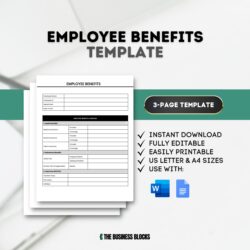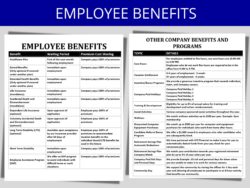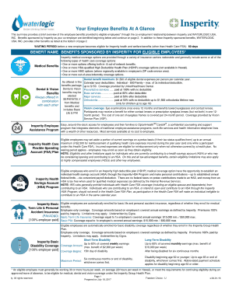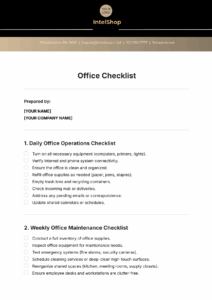Using such a framework can significantly improve the enrollment process for both employees and human resources departments. It empowers employees to make informed decisions about their benefits by providing easy-to-understand explanations and comparisons. Simultaneously, it streamlines administrative tasks by offering a consistent resource that reduces inquiries and errors. This leads to a more efficient and less stressful enrollment experience for all involved.

The following sections will delve into the essential components of a well-designed framework for benefits communication, offering practical advice and examples for creating a resource that effectively supports employees during the enrollment process. These components include clear explanations of plan options, detailed cost breakdowns, and step-by-step guidance on how to enroll.
Key Components of a Benefits Enrollment Resource
Effective communication is crucial for successful benefits enrollment. A well-structured resource should include the following components:
1. Introduction and Purpose: A clear introductory statement establishes the document’s purpose and target audience. It should briefly explain the importance of benefits enrollment and the guide’s role in assisting employees.
2. Eligibility Criteria: Specific eligibility requirements for each benefit should be clearly outlined. This includes full-time versus part-time status, employment duration, and any other relevant factors.
3. Plan Options: A comprehensive overview of available benefits, including health insurance, retirement plans, life insurance, disability coverage, and other perks, should be provided. Each option requires a concise explanation of coverage details, including key features and limitations.
4. Cost Information: Transparent cost breakdowns for each plan are essential. This includes premium contributions, deductibles, co-pays, and out-of-pocket maximums. Clear presentation of cost information empowers informed decision-making.
5. Enrollment Procedures: Step-by-step instructions on how to enroll in each benefit should be clearly articulated. This includes online enrollment portals, required forms, deadlines, and contact information for assistance.
6. Glossary of Terms: A glossary of common benefits terms helps employees understand complex terminology and navigate the enrollment process with greater confidence.
7. Frequently Asked Questions (FAQs): Addressing common employee questions proactively can significantly reduce inquiries to human resources and improve overall satisfaction.
8. Contact Information: Providing clear contact information for human resources or benefits administrators allows employees to seek personalized assistance and resolve any outstanding questions.
A comprehensive resource that incorporates these elements supports informed decision-making, simplifies the enrollment process, and fosters a positive experience for employees during this critical period.
How to Create a Benefits Enrollment Resource
Creating a comprehensive benefits enrollment resource requires careful planning and execution. A structured approach ensures clarity, accuracy, and accessibility for all employees.
1. Define Objectives and Audience: Clearly define the purpose of the resource and the specific needs of the target audience. Consider employee demographics, benefit preferences, and communication styles.
2. Gather Information: Compile all relevant information regarding benefit plans, eligibility criteria, costs, enrollment procedures, and deadlines. Ensure accuracy and consistency across all data points.
3. Structure Content Logically: Organize the content in a logical and user-friendly manner. Utilize headings, subheadings, bullet points, and clear formatting to improve readability and navigation.
4. Develop Content: Craft clear and concise explanations for each benefit option. Avoid technical jargon and use plain language that is easily understood by all employees.
5. Incorporate Visuals: Utilize visuals such as charts, graphs, and tables to present complex information in a digestible format. Visual aids can enhance understanding and engagement.
6. Review and Refine: Thoroughly review and refine the resource for accuracy, clarity, and completeness. Seek feedback from key stakeholders to ensure the document meets the needs of the intended audience.
7. Choose a Distribution Method: Select an appropriate distribution method for the resource. Options include online platforms, printed booklets, and email distribution. Consider accessibility and employee preferences.
8. Communicate and Promote: Communicate the availability of the benefits enrollment resource to all eligible employees. Promote its use through various channels, including company newsletters, intranet announcements, and informational sessions.
A well-designed resource that follows these steps ensures effective communication and supports informed decision-making during the benefits enrollment period. Regular updates and revisions are essential to maintain accuracy and relevance.
A well-structured framework for disseminating benefits information is essential for a smooth and efficient enrollment process. It provides clarity for employees navigating complex decisions and streamlines administrative tasks for human resources departments. By offering comprehensive plan explanations, cost breakdowns, and step-by-step enrollment instructions, such a framework empowers informed choices and reduces potential confusion. Accuracy, clarity, and accessibility are paramount in maximizing the effectiveness of this resource.
Effective communication during open enrollment strengthens the employee-employer relationship and fosters a positive workplace environment. Organizations are encouraged to prioritize the development and implementation of a user-friendly resource that supports informed decision-making and promotes employee well-being. Regular review and refinement of this framework are crucial to ensure its continued relevance and effectiveness in meeting evolving employee needs and regulatory changes.



